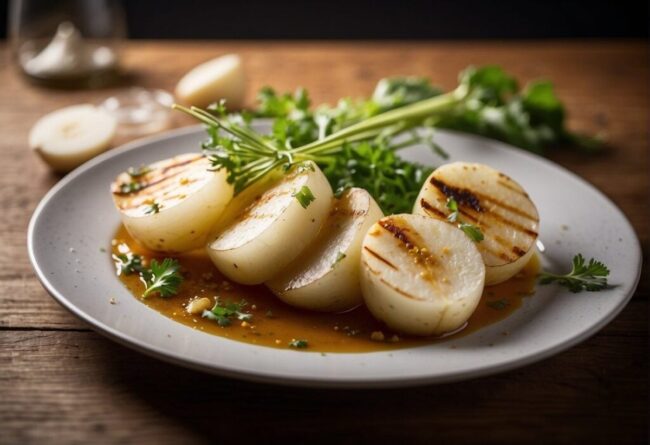Simple Turnip Preparation Techniques for Any Meal
Turnip preparation techniques unlock creative ways to elevate this humble root into unexpected culinary delights.
A blend of time-honored methods and modern twists transforms turnips into stars of hearty stews, crisp roasts, and vibrant salads.
Flavors shift from gentle sweetness to savory earthiness that surprises and satisfies.
What Steps to Prepare Turnips
Turnips offer a unique flavor and versatility in cooking. Here are simple methods to add this root vegetable to your meals.
Checking Freshness and Quality
Choosing the right turnips involves a keen eye for quality.
Firmness and weight are essential indicators of freshness; a heavy turnip often means better flavor.
Smooth skin without any blemishes speaks to its healthiness, ensuring you avoid any hidden spoilage.
Smaller varieties typically offer a sweeter taste and tender texture that can elevate your dishes.
Larger turnips, while more fibrous, have their own charm in heartier recipes where robustness is key.
Storage Methods
Turnips thrive in specific conditions that help maintain their freshness.
A cool, dark environment works wonders, especially with humidity levels hovering around 90-95%.
The optimal temperature range for storage lies between 32-40°F (0-4°C).
Removing the greens from turnips prevents unwanted moisture loss, keeping them crisp and ready to use.
Placing them in the crisper drawer of your refrigerator is an excellent way to achieve ideal humidity and temperature.
Wash and Peel
Start by scrubbing the turnips with a vegetable brush under running water to eliminate any dirt.
A thorough cleaning is essential for a smooth peeling process, ensuring no soil seeps into the edible part.
With your vegetable peeler in hand, grip the turnip firmly and peel from top to bottom.
This method efficiently removes the tough outer layer and exposes that delicate inner flesh waiting to be used in your dish.
The result?
Fresh, clean turnips ready for cooking or roasting without any unwanted grit lingering around!
Slicing and Dicing
Peeling turnips is just the beginning.
Thick rounds create a solid base for slicing, ensuring safety as you work.
Stacking those rounds simplifies the dicing process into neat sticks before chopping them into cubes.
Julienne cuts add an elegant touch; simply reposition those sticks and slice them thinly for refined pieces.
Mastering these techniques not only makes cooking easier but also elevates your dishes with precision and style.
Cooking Turnips in Water
Boiling turnips offers a simple way to enjoy this nutritious vegetable.
Start by peeling and chopping them into uniform pieces for even cooking.
The transformation happens as they simmer in salted boiling water, becoming tender within 20 to 30 minutes.
After draining the pot, mashing or seasoning can elevate their flavor profile significantly.
This method ensures that you retain the natural taste while keeping preparation effortless and quick.
Baking Turnips
Roasting turnips brings out their natural sweetness and earthy flavor.
The process begins with simple preparation, transforming raw vegetables into a delicious side dish.
Olive oil, salt, and pepper enhance the taste while ensuring a crispy texture on the outside.
The golden hue achieved during roasting adds an appealing visual element to your meal.
Serve them warm for a delightful addition to any dinner plate that elevates your dining experience effortlessly.
Cooking Turnips Slowly
Braising brings out the best in turnips, creating a deliciously tender dish.
Slicing them first allows for an even cook and enhances their natural sweetness.
Slightly browning in oil or butter develops a rich flavor base that pairs perfectly with the braising liquid.
After simmering for about 30 minutes, those humble turnips transform into a delightful side that complements any meal.
This technique not only enriches taste but also showcases the versatility of this often-overlooked vegetable.
Baking and More Ways
Turnips can surprise you with their versatility in the kitchen.
Mixing them into gratins or casseroles elevates any meal, creating a dish that feels both hearty and comforting.
The process begins by preheating your oven to 375°F (190°C) and combining turnips with ingredients like cheese or breadcrumbs for added texture and flavor.
Baking brings out a wonderful creaminess, transforming these root vegetables into something truly special after about 40 minutes in the oven.
For those looking for quicker methods, steaming or microwaving also softens turnips while keeping their nutrients intact, making it easy to incorporate this nutritious vegetable into your daily meals without much fuss.
Herbs and Spices for Flavor
Turnips have a delightful earthiness that can shine through with the right enhancements.
Salt and pepper play a crucial role, enhancing their natural taste in every bite.
Fresh herbs like thyme or rosemary introduce aromatic layers, transforming ordinary dishes into something special.
Garlic adds an exciting kick, bringing out the peppery essence beautifully.
Experimenting with these ingredients opens up new dimensions of flavor that elevate your culinary creations effortlessly.
Meat and Veggie Pairings
Turnips hold a special place in the kitchen due to their adaptability.
These root vegetables enhance the flavors of hearty meats like beef, allowing for a delightful contrast that excites the palate.
Pairing turnips with cabbage introduces an interesting texture and taste combination, creating a vibrant dish that surprises your senses.
Mixing them into salads adds crunch and freshness, making every bite refreshing.
Enjoy experimenting with this humble vegetable; it invites creativity and culinary exploration at every meal.
Turnip Varieties and Their Uses
Turnips come in various sizes and colors, each offering unique flavors and textures. They are commonly used in soups, stews, and roasted vegetable dishes.
Young Turnips for Salads
Young turnips, especially the Hakurei type, shine when served raw.
Their light sweetness pairs beautifully with fresh salad components.
A crisp bite enhances the overall texture without overshadowing other flavors.
Thin slices of baby bunch turnips blend seamlessly into your greens, adding both charm and freshness to each mouthful.
Elevate your salad game by including these vibrant gems for an exciting taste experience!
Mature Turnips for Hearty Meals
Mature turnips add a robust taste and firm texture to savory stews.
These vegetables soak up spices beautifully, enhancing slow-cooked meals.
Varieties like Milan and Scarlet shine with their unique flavor profiles, transforming into tender delights when given time in the pot.
The gradual cooking process unlocks their rich essence, blending harmoniously with other ingredients.
Stews made this way become a satisfying experience that warms both body and spirit.
Recipes and Serving Ideas for Turnips
Turnips can be roasted, mashed, or used in soups for a mild, slightly sweet flavor. They pair well with herbs, spices, and various proteins in hearty meals.
Creamy Turnip Mash
Mashed turnips provide a delightful alternative to traditional mashed potatoes.
The creamy texture pairs beautifully with various main dishes, enhancing any meal's appeal.
Fresh garlic or fragrant herbs like thyme elevate their flavor profile, creating an inviting aroma in your kitchen.
Serving them warm adds a comforting touch that complements gatherings and casual dinners alike.
Simple preparation makes this dish accessible for both novice cooks and seasoned chefs looking for something different.
Turnip Gratin and Sides
Turnip gratin offers a delightful twist on classic comfort food.
Layers of thinly sliced turnips combined with rich cheese create a creamy texture that satisfies cravings.
Nutmeg adds an unexpected warmth, enhancing the overall flavor profile beautifully.
Roasting turnips as fries presents another fun option, giving you a crunchy snack without the guilt of regular fries.
This dish invites creativity while ensuring everyone at the table finds something to love about it.
Creative Turnip Recipes
Turnips offer a world of culinary potential that you might not have considered.
Adding them to stews introduces an earthy depth, elevating the flavor profile of your favorite dishes.
Glazing turnips with butter, sugar, and herbs transforms them into a sweet-savory delight that complements any meal beautifully.
Tossing sautéed or steamed turnips with garlicky breadcrumbs and Parmesan creates a satisfying crunch alongside their tender texture.
Exploring these options can lead to exciting new tastes in your kitchen adventures.
Advanced Techniques for Cooking Turnips
Advanced cooking techniques for turnips include caramelizing, sous vide preparation, and fermenting. These methods enhance their natural sweetness and texture.
Blanching for Uniform Cooking
Blanching serves as an essential technique to enhance the cooking experience.
Boiling water and an ice bath are key components in this method.
Turnips sliced uniformly allow for consistent heat exposure, ensuring a balanced texture throughout.
A brief boil softens them just enough without losing their bright color or introducing bitterness.
Transferring the turnips to an ice bath halts cooking instantly, preparing them perfectly for whatever dish you plan next.
Getting the Right Texture
Cooking turnips offers a delightful range of textures that can elevate any dish.
Tender and succulent results come from low-temperature cooking, allowing the natural juices to seep out for an irresistible softness.
Roasting or sautéing creates a satisfying contrast with its crisp exterior paired with a tender inside, enhancing every bite.
For those who prefer firmness and crunchiness, briefly cooking blanched turnips over high heat delivers just the right amount of snap.
Mastering these techniques opens up exciting culinary adventures in your kitchen!
Unique Ways to Use Turnips
Unique ways to use turnips include making turnip fries, adding them to stir-fries, or using them in slaws. Their versatility makes them a great low-carb alternative.
Fermenting and Pickling Turnips
Lactic acid fermentation offers a fascinating way to elevate raw turnips into a tangy, probiotic-rich delight.
This method transforms simple ingredients into something extraordinary.
Slicing the turnips thinly allows them to absorb the brine effectively, enhancing their flavor profile.
After sealing the jar and letting it sit for several days, patience rewards you with vibrant pickled turnips that complement various dishes beautifully.
Whether served alongside falafel or on mezze platters, these colorful bites provide an exciting contrast in both taste and texture that can invigorate any meal experience.
Low-Carb Diet Options
Turnips serve as an excellent alternative to starchy vegetables, offering a low-carb option that fits various dietary needs.
Their texture resembles that of potatoes when cooked, allowing for creative uses in different dishes.
Mashed turnips provide a creamy side dish perfect for any meal, while roasted cubes deliver a satisfying crunch and flavor explosion.
Spiralizing them into noodles opens up endless opportunities for unique pasta recipes without the carbs associated with traditional options.
With their subtle taste, these root vegetables seamlessly blend into countless recipes and contribute to healthier eating habits without sacrificing flavor or satisfaction.

